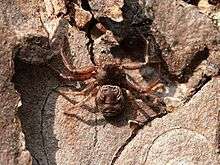Coriarachne
Coriarachne is a genus of crab spiders that was first described by Tamerlan Thorell in 1870.[2] Over half of described species have been synonymized or moved to similar genera, including Bassaniana, Bassaniodes, and Pycnaxis.[1]
| Coriarachne | |
|---|---|
 | |
| C. depressa | |
| Scientific classification | |
| Kingdom: | Animalia |
| Phylum: | Arthropoda |
| Subphylum: | Chelicerata |
| Class: | Arachnida |
| Order: | Araneae |
| Infraorder: | Araneomorphae |
| Family: | Thomisidae |
| Genus: | Coriarachne Thorell, 1870[1] |
| Type species | |
| C. depressa (C. L. Koch, 1837) | |
| Species | |
|
4, see text | |
They are found in boreal and temperate regions almost exclusively on tree bark, wooden fence posts and similar areas where they can take advantage of their natural camouflage. They are rather slow-moving and robust, with the crab-like appearance characteristic of the subfamily Thomisinae. Similar to others in its subfamily, they will wait to ambush their prey rather than actively pursuing it. Often these spiders will congregate under loose bark, leaf litter, or similar situations to spend the winter either in the adult or penultimate stage.[3]
Species
As of July 2020 it contains four species, found in Europe, Asia, Canada, and the United States:[1]
- Coriarachne brunneipes Banks, 1893 – USA, Canada
- Coriarachne depressa (C. L. Koch, 1837) (type) – Europe, Turkey, Caucasus, Russia (Europe to Far East), Central Asia
- Coriarachne fulvipes (Karsch, 1879) – Korea, Japan
- Coriarachne melancholica Simon, 1880 – China
Formerly included:
- C. fienae Jocqué, 1993 (Transferred to Bassaniodes)
- C. floridana Banks, 1896 (Transferred to Bassaniana)
- C. nigrostriata Simon, 1886 (Transferred to Pycnaxis)
- C. utahensis (Gertsch, 1932) (Transferred to Bassaniana)
- C. versicolor Keyserling, 1880 (Transferred to Bassaniana)
In synonymy:
- C. nakina Gertsch, 1953 = Coriarachne brunneipes Banks, 1893
- C. potanini Schenkel, 1963 = Coriarachne melancholica Simon, 1880
- C. lenta (Walckenaer, 1837
See also
References
- "Gen. Coriarachne Thorell, 1870". World Spider Catalog Version 20.0. Natural History Museum Bern. 2020. doi:10.24436/2. Retrieved 2020-08-03.
- Thorell, T. (1870). "On European spiders". Nova Acta Regiae Societatis Scientiarum Upsaliensis. 7 (3): 109–242.
- (Jennings, 1972 ; Holmquist, 1926 ; Kaston, 1948 ; Lowrie, 1948)
Further reading
- Bowling, T. A.; Sauer, R. J. (1975). "A taxonomic revision of the crab spider genus Coriarachne (Araneida, Thomisidae) for North America north of Mexico". Journal of Arachnology. 2: 183–193.
- Song, D. X.; Zhu, M. S. (1997). Fauna Sinica: Arachnida: Araneae: Thomisidae, Philodromidae. Science Press, Beijing. p. 259.
- Hu, J. L. (1984). The Chinese spiders collected from the fields and the forests. Tianjin Science and Technology Press. p. 482.
- Gertsch, W. J. (1953). "The spider genera Xysticus, Coriarachne and Oxyptila (Thomisidae, Misumeninae) in North America". Bulletin of the American Museum of Natural History. 102: 415–482.
- Yin, C. M.; et al. (2012). Fauna Hunan: Araneae in Hunan, China. Hunan Science and Technology Press, Changsha. p. 1590.